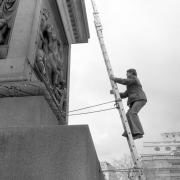Although one might foolishly be tempted to take some tiny crumb of comfort from the fact that the numbers of construction deaths resulting from falls from height has reduced ever-so slightly in the past few years, the latest report from the All Party Parliamentary Group on Working at Height still makes for grim reading.
As result, it’s imperative that the sector redoubles its safety training efforts to ensure that all its workers can be confident of coming home in one piece at the end of the day. The onus falls on all of us – in our case, an agency that finds itself on scaffolds and ladders conducting interviews or overseeing photography – to ensure the highest standards are maintained and properly communicated to those at risk.
If you drill into the RIDDOR (Reporting of Injuries, Diseases and Dangerous Occurrences Regulations) numbers, one shocking finding is how disproportionately older workers figure among the casualties. Incredibly, 35% of fatalities are over 60 – including a number of 70-year olds. When you drop the bar to 45+, older workers comprise 64% of the deaths.
At risk of inferring too much from this, it might be thought that we are suffering from a legacy issue – whereby workers came into construction in the days before training, tickets and the higher health and safety consciousness we have today. A 55-year old site worker now, for example, would have entered the industry at a time when even hard hats weren’t commonplace.
So while we shouldn’t take the inculcation of youngsters and apprentices into the best, safest practices for granted, we must be mindful that learning is a lifelong process and place additional emphasis on increasing safety awareness among those already well established in the ranks.
We had our own mea culpa over taking things for granted in this respect when it came to our business insurances renewal. Reading the small print (probably for the first time, to be honest), we noticed that not only we were not covered for work involving scaffolds and ladders – see above – it was specifically excluded.
And then trying to obtain that cover provided a chore as our broker struggled to communicate to insurers why we needed it and they didn’t have a category in which we conveniently sat. Lots of ringing around etc…
Having cracked that – and thus with a heightened (no pun) awareness of the issue – we also recognised that learning should be a lifelong process for the, essentially senior, team: we then set about identifying a suitable training module covering working at height. Why it hadn’t occurred to us before is slightly shaming when, for instance, we all own PPE for just those tasks.
It goes to show that enjoying a safe place of work concerns us all, and we should work together to make sites resemble the ordinary places of work enjoyed by much of the population as a whole; and less like the casualty departments they can be.

